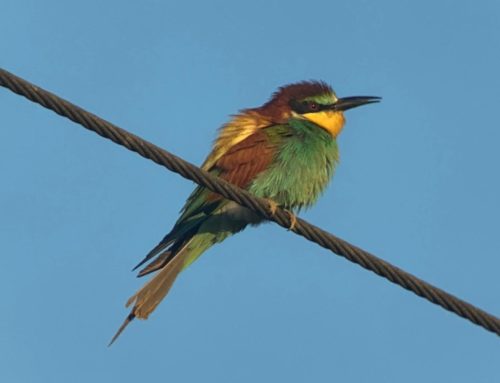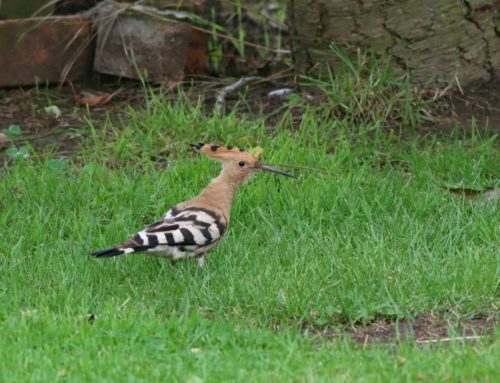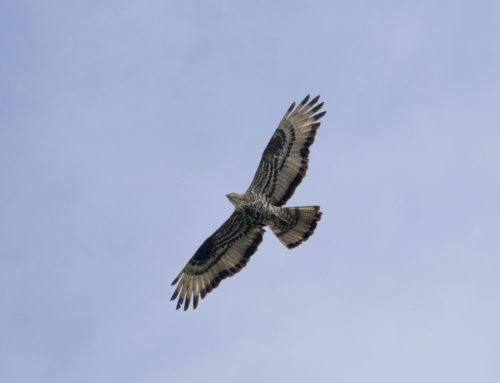B is for Bee-eater – but who pays and from where?
Mark Thomas, Head of Investigations at the RSPB, has been involved protecting many rare breeding birds over the last twenty years, and sometimes gets the chance to share these birds with birdwatchers and the wider public. He has overseen the protection and public viewing point for the Bee-eaters that have bred at Trimingham, Norfolk this summer, and here shares some thoughts on the trials, tribulations and rewards of such viewing schemes.

One of the Bee-eaters breeding at Trimingham, Norfolk. Photo: RSPB.
You could be mistaken to think that working in RSPB Investigations is all doom and gloom. Whilst it can be, and we are emotionally trained to rise to that challenge, it can also be highly rewarding, especially so when dealing with rare breeding birds – which is essentially crime prevention in policing terms.
Over the years this area of work has morphed from seemingly keeping secrets to actually seeking opportunities to facilitate mass participation viewing schemes, providing opportunities that otherwise would be off limits. Such RSPB-led schemes have centred, amongst others, on Montagu’s Harriers, Bee-eaters – now six times! – Black-winged Stilts and, of course, Ospreys since the early years of their colonisation in Scotland.
The thing about viewing schemes is that almost everyone is truly grateful for your efforts (always a few who would like to get closer or laughably see it as a money-making exercise), and it enables long-lasting partnerships to be forged with individuals, bird clubs, conservation organisations and local communities – that is priceless.

The Bee-eater breeding site at Trimingham quarry. Photo: RSPB.
My own personal journey began with the Durham Bee-eaters in 2002, once I knew they were nest scraping I arrived with my tent and border collie Sam and didn’t leave until we had employed staff, partnered with Durham Wildlife Trust and had a packed protection rota of local birding volunteers. You don’t get a second attempt with rare breeders; once you make the decision to commit you have to go hard and fast. That first 48 hours is frantic, it has to be and it sets the entire scheme up for the best chance of success. There isn’t always success, the Bee-eaters that were dug out and predated by foxes remind us of that – it was beyond our control as the landowner would not grant us access to guard that nest, a lesson learnt there. In Nottinghamshire the weather beat us, Bee-eaters can’t cope with four days of constant rain.
So how do we do it? Firstly we need to know, and as soon as possible. Bear in mind the guidance (see here) provided by the RBBP on keeping sensitive bird news confidential, to prevent disturbance, or worse. Even so, bird news has a tendency to leak out, so even if the best course of action is ultimately to keep the news secret, it is sensible to let us know. We have to be informed early please, to get ahead of the curve. We will then visit the site and give practical advice on the limitations and possibilities. Ultimately, protection schemes need resources and most conservation bodies do not have pots of money sitting around for such ad-hoc happenings. The reality is that conservation budgets are planned and spent on predictable core needs, not seemingly random rock star Bee-eaters! So, we have to be adaptive in our line of work, the parking fee is the ‘be all and end all’ – it will have to cover the cost of temporary wardens, temporary accommodation, protection equipment, toilets and much more. If the books are balanced at the end, then a good job has been done – remember the landowner gets half, for their allowance of thousands of visitors on their land.

Visitors at the Trimingham Bee-eater viewing point. Photo: RSPB
But it’s more than that, so much more – it brings huge and sudden profile to organisations and critical issues, such as climate change which is bringing Bee-eaters and others to the UK with increasing frequency. For some species, breeding attempts have passed from one-off events to regular occurrences that no longer need protection – such as for Great White Egrets, for example.
Day to day operation of protection schemes requires many skills – not least visitor management and media skills – alongside the core nest protection. And the infrequency of such breeding events means their management has to be unplanned ‘corner of the desk’ work, with normal work going on at full pace alongside it.
Another great thing about these schemes is that you find some real gems of people who you often employ on their first contract but go on to develop careers in conservation – that’s a delight to see. Equally, the volunteers are truly amazing; they quickly become the backbone of the project and are essential to its eventual success.

Part of the RSPB Bee-eater viewing scheme, Trimingham. Photo: RSPB
We have enjoyed the many positive comments on social media around the Trimingham Bee-eaters. Occasionally you are gifted a site that is just perfect and everything falls in to place – this is the case here. The landowner is superb, fully on-side, and the viewing situation provides excellent views but without causing any disturbance at all to the birds. The NE Norfolk Bird Club and the local birders have been a joy to partner with. When a circus of colour comes to town you need such people on your side! Just imagine if RSPB hadn’t stepped in here – ‘not part of our plans’ or some other such excuse, the criticism would rightly have been universal.
On site, days are long, often with around the clock protection rotas and your enthusiasm to greet and engage with each and every visitor has to be unwavering. It’s impossible to quantify two very important things, the immediate positive personal impact of seeing birds like Bee-eaters and the deep impact that has on a person’s long-term commitment to conservation issues. Finally, one thing for sure… as a child I would have begged my parents relentlessly to take me to a Bee-eater viewing scheme – I hope that is the case for others now and their dreams are met, after all they could be our conservation leaders of the future!







I was on business at Norwich from Newcastle on the 8th of August, and took the opportunity to visit the RSPB site at Trimingham that afternoon. The scene of the Bee Eaters flying around the quarry is unforgettable, not to mention how helpful the RSPB staff were with everyone.